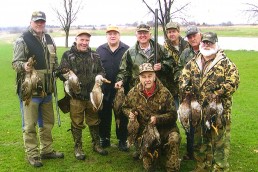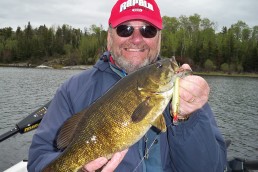Fall Waterfowl Prospects in General
SHARE THIS POST
In these days of absurd weather disruptions, I surely won’t fall into the trap of pretending to know, or even speculate on how, the upcoming waterfowl hunting season is going to play out. I can’t, with the slightest degree of certainty, tell you when, where, why or even if the annual migration will reach your favorite hunting area. Heck, the ducks and geese themselves don’t even know that!
The one thing I can predict is that the birds will predictably react to whatever conditions they encounter on their travels along the flyways. And, the one overarching factor that the recent warming trends have made clear is, that there really are no such things as “wintering grounds.”
The idea that ducks and geese have a clear-cut destination in mind when they leave the Canadian prairies totally collapsed last season, when the migratory flight stalled in mid-continent, leaving the Gulf Coast states with little more than a bunch of teal, and Arkansas, the “mallard capital,” with a bunch of nothing.
We always were aware that migrating waterfowl advance down the flyway in response to harsh winter weather. They will fly south as far as necessary to find suitable habitat, and then settle in to await the next storm front that urges them on. But, what if that next storm front never arrives?
Lacking the impetus of a freeze out, the birds will simply sit tight, and wherever they happen to be will their “wintering grounds.” Last season, a line drawn along central Nebraska’s Platte River would show you where most of the Mississippi Valley Flyway’s ducks spent their winter. After a few days, the birds learned the safe roosting and feeding areas, became “stale,” and were virtually unhuntable. The same thing happened all along that line into Iowa, Missouri and Illinois; plenty of ducks, but not much hunting.
It is important for waterfowl hunters to be aware of these changing conditions, and how they affect their sport. The first human response to an unfavorable situation is denial. “Nothing is wrong; it was just a bad year.” (Chicago Cubs fans will recognize this as the “Wait ‘til next year” syndrome.)
When things don’t improve, anger sets in. “Someone is intentionally causing this to happen.” That, pretty much, is where we are at now. I have heard hunters complain that some exclusive hunting clubs to their north were maintaining heated ponds to hold the ducks. In reality, those exclusive, high-priced clubs were enduring their worst hunting seasons ever, and there were no heated ponds.
Some frustrated hunters were firing arrows at Ducks Unlimited projects, and state and federal waterfowl refuge mangers for planting huge amounts of food crops to hold the birds within the safety of the refuge. But, most of the refuges and D.U. habitat projects incorporate hunting programs within their boundaries. So, clearly they are not attempting to discourage hunting, but rather to promote hunting by providing the habitat necessary to the maintenance of a large, healthy waterfowl population.
Are you enjoying this post?
You can be among the first to get the latest info on where to go, what to use and how to use it!
Now, there are signs hunters are reaching the final phase—acceptance. “O.K., things have changed, and possibly could change some more. What are we going to do about it?”
Well, your tactics will be dictated by your locality. In some places, hunting may be the same, or even better than before. In other areas, hunters may well be reminiscing about “the good old days.” I have every confidence that resourceful hunters will figure it out.
The main thing we should all strive for is to maintain the abundant waterfowl population we now enjoy. The current population estimate isn’t in yet, but without doubt, and based on last spring’s nesting conditions, the fall flight will consist of just about the same number of birds as it did last year. Except forpin tail and scaup (blue bill), all species will be well above their long-term averages.
This is great news, and the secret to continued success is providing and protecting sufficient habitat for the birds to prosper. Many wetlands have been drained, mainly for agricultural purposes, and nesting sites in grasslands have been destroyed by the plow. The habitat that remains must be protected, and where possible, habitat that has been destroyed must be restored.
The challenge is that, of the entire North American population, only 5 percent of us are waterfowl hunters. And of that small group, only 64 percent have ever contributed to wetlands or waterfowl conservation. That means 36 percent of hunters are along for a free ride. That has to change.
Both Federal and state governments have significant programs in place to conserve and protect wetlands, but here is a real eye opener. In 2011, Ducks Unlimited launched a massive fundraising effort termed Rescue Our Wetlands, with the ambitious goal set at $2 billion. Yeah, $2,000,000,000. In December, 2018, the campaign closed with an astounding total of $2.34 billion in the bank. These funds have been used to conserve 2,236,435 acres of waterfowl habitat (nearly 3,500 square miles), as well as to fund educational and organizational projects throughout North America.
While D.U. concentrates its efforts mainly on habitat projects, Delta Waterfowl is an important conservation organization that focuses on scientific research projects that benefit waterfowl.
Without the important work of these organizations, and the lobbying they do to encourage governmental support for wetland conservation, your duck and goose hunting would be a “bad year” every year. Check them both out online, and then join and support their efforts to conserve our waterfowl natural resource. Do your part.
MWO
SHARE THIS POST
Did you enjoy this post?
You can be among the first to get the latest info on where to go, what to use and how to use it!
Jerry Pabst
Jerry Pabst has been writing about the outdoors for over 40 years. He captained a Lake Michigan charter boat for 25 years and was inducted into the Fresh Water Fishing Hall of Fame. He has hunted waterfowl in all North American flyways, pursued upland game extensively, and trains his own dogs.



